Analysis of Australian Fiscal Policies and Strategies from 2014-2017
VerifiedAdded on 2020/03/04
|13
|3845
|41
Report
AI Summary
This report provides a comprehensive analysis of Australia's fiscal policies implemented between 2014 and 2017. It begins with an overview of the Australian economy, highlighting its key characteristics, GDP, economic growth, and major economic issues, including unemployment, public debt, and housing affordability. The report then delves into the fiscal strategies adopted during the financial years 2014-15, 2015-16, and 2016-17, examining the government's objectives, including achieving a budget surplus, reducing debt, and stimulating economic activity through investments and tax reforms. The analysis covers key policy elements such as redirecting government spending, maintaining fiscal discipline, and strengthening the government's balance sheet. The report assesses the impact of these policies on the economy, including changes in government spending, tax rates, and the overall fiscal position, while also considering the global financial crisis and its impact on Australia's economic stability. The report further discusses the government's focus on tax reforms, including reduced corporate tax and GST application on digital products, and efficient public spending to enhance welfare and public projects with long-term returns.
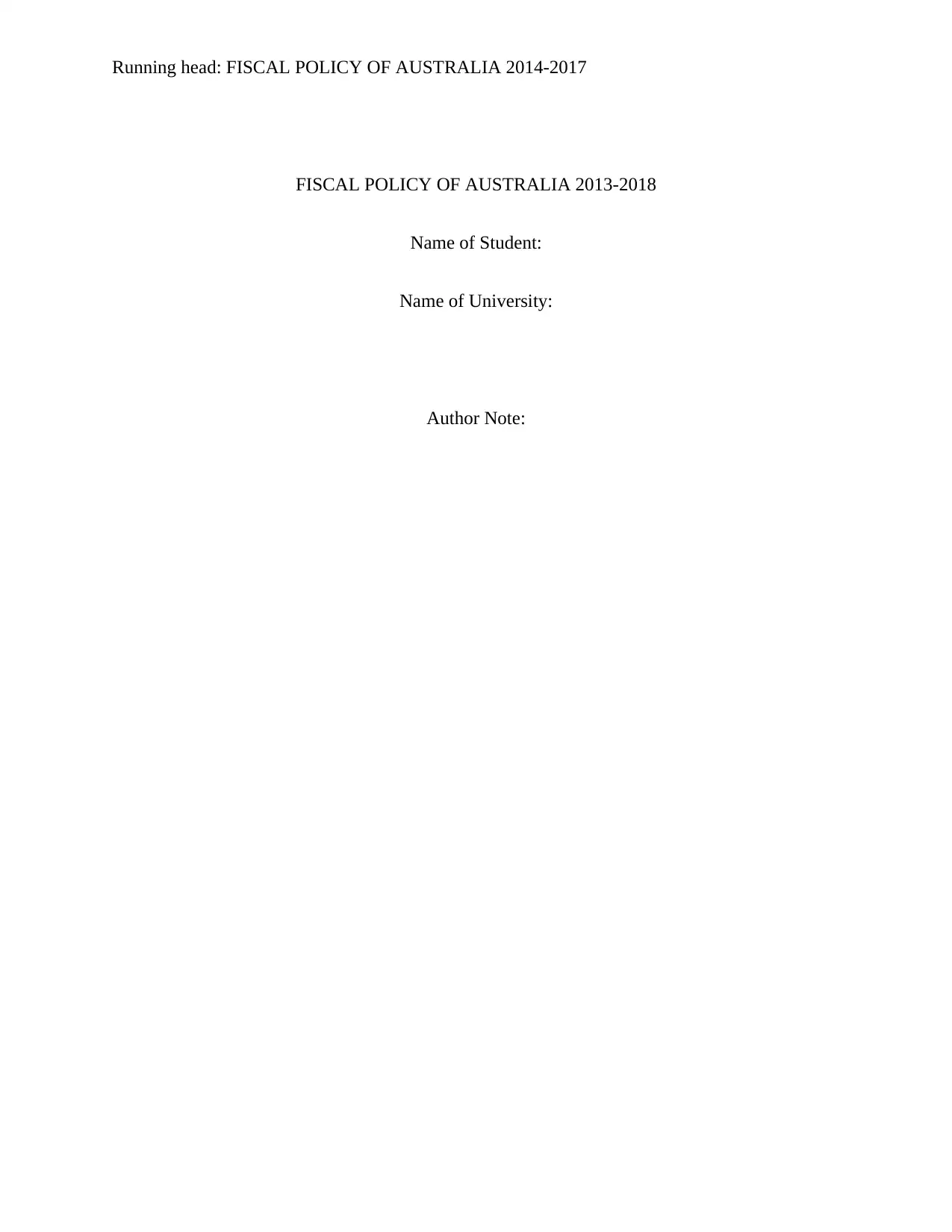
Running head: FISCAL POLICY OF AUSTRALIA 2014-2017
FISCAL POLICY OF AUSTRALIA 2013-2018
Name of Student:
Name of University:
Author Note:
FISCAL POLICY OF AUSTRALIA 2013-2018
Name of Student:
Name of University:
Author Note:
Paraphrase This Document
Need a fresh take? Get an instant paraphrase of this document with our AI Paraphraser
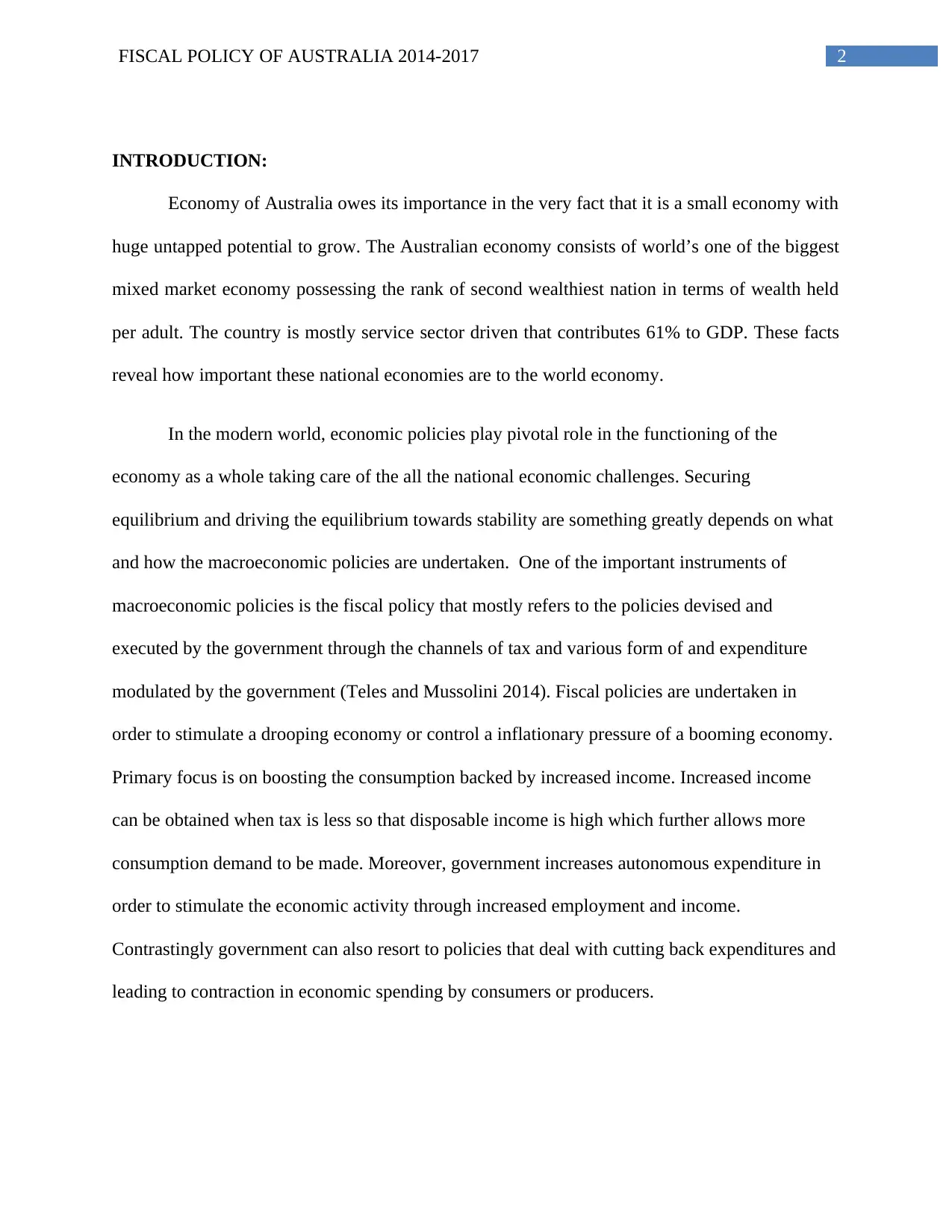
2FISCAL POLICY OF AUSTRALIA 2014-2017
INTRODUCTION:
Economy of Australia owes its importance in the very fact that it is a small economy with
huge untapped potential to grow. The Australian economy consists of world’s one of the biggest
mixed market economy possessing the rank of second wealthiest nation in terms of wealth held
per adult. The country is mostly service sector driven that contributes 61% to GDP. These facts
reveal how important these national economies are to the world economy.
In the modern world, economic policies play pivotal role in the functioning of the
economy as a whole taking care of the all the national economic challenges. Securing
equilibrium and driving the equilibrium towards stability are something greatly depends on what
and how the macroeconomic policies are undertaken. One of the important instruments of
macroeconomic policies is the fiscal policy that mostly refers to the policies devised and
executed by the government through the channels of tax and various form of and expenditure
modulated by the government (Teles and Mussolini 2014). Fiscal policies are undertaken in
order to stimulate a drooping economy or control a inflationary pressure of a booming economy.
Primary focus is on boosting the consumption backed by increased income. Increased income
can be obtained when tax is less so that disposable income is high which further allows more
consumption demand to be made. Moreover, government increases autonomous expenditure in
order to stimulate the economic activity through increased employment and income.
Contrastingly government can also resort to policies that deal with cutting back expenditures and
leading to contraction in economic spending by consumers or producers.
INTRODUCTION:
Economy of Australia owes its importance in the very fact that it is a small economy with
huge untapped potential to grow. The Australian economy consists of world’s one of the biggest
mixed market economy possessing the rank of second wealthiest nation in terms of wealth held
per adult. The country is mostly service sector driven that contributes 61% to GDP. These facts
reveal how important these national economies are to the world economy.
In the modern world, economic policies play pivotal role in the functioning of the
economy as a whole taking care of the all the national economic challenges. Securing
equilibrium and driving the equilibrium towards stability are something greatly depends on what
and how the macroeconomic policies are undertaken. One of the important instruments of
macroeconomic policies is the fiscal policy that mostly refers to the policies devised and
executed by the government through the channels of tax and various form of and expenditure
modulated by the government (Teles and Mussolini 2014). Fiscal policies are undertaken in
order to stimulate a drooping economy or control a inflationary pressure of a booming economy.
Primary focus is on boosting the consumption backed by increased income. Increased income
can be obtained when tax is less so that disposable income is high which further allows more
consumption demand to be made. Moreover, government increases autonomous expenditure in
order to stimulate the economic activity through increased employment and income.
Contrastingly government can also resort to policies that deal with cutting back expenditures and
leading to contraction in economic spending by consumers or producers.
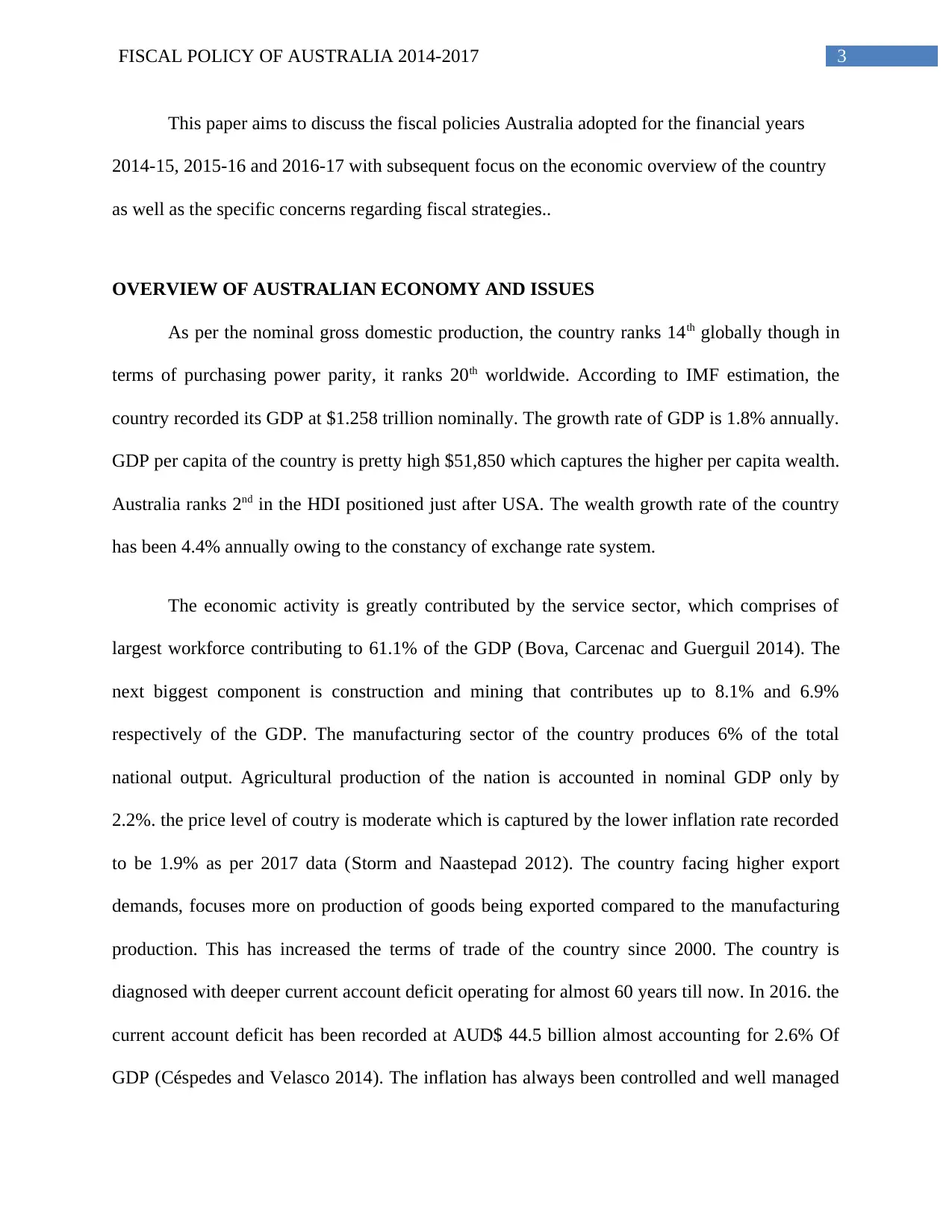
3FISCAL POLICY OF AUSTRALIA 2014-2017
This paper aims to discuss the fiscal policies Australia adopted for the financial years
2014-15, 2015-16 and 2016-17 with subsequent focus on the economic overview of the country
as well as the specific concerns regarding fiscal strategies..
OVERVIEW OF AUSTRALIAN ECONOMY AND ISSUES
As per the nominal gross domestic production, the country ranks 14th globally though in
terms of purchasing power parity, it ranks 20th worldwide. According to IMF estimation, the
country recorded its GDP at $1.258 trillion nominally. The growth rate of GDP is 1.8% annually.
GDP per capita of the country is pretty high $51,850 which captures the higher per capita wealth.
Australia ranks 2nd in the HDI positioned just after USA. The wealth growth rate of the country
has been 4.4% annually owing to the constancy of exchange rate system.
The economic activity is greatly contributed by the service sector, which comprises of
largest workforce contributing to 61.1% of the GDP (Bova, Carcenac and Guerguil 2014). The
next biggest component is construction and mining that contributes up to 8.1% and 6.9%
respectively of the GDP. The manufacturing sector of the country produces 6% of the total
national output. Agricultural production of the nation is accounted in nominal GDP only by
2.2%. the price level of coutry is moderate which is captured by the lower inflation rate recorded
to be 1.9% as per 2017 data (Storm and Naastepad 2012). The country facing higher export
demands, focuses more on production of goods being exported compared to the manufacturing
production. This has increased the terms of trade of the country since 2000. The country is
diagnosed with deeper current account deficit operating for almost 60 years till now. In 2016. the
current account deficit has been recorded at AUD$ 44.5 billion almost accounting for 2.6% Of
GDP (Céspedes and Velasco 2014). The inflation has always been controlled and well managed
This paper aims to discuss the fiscal policies Australia adopted for the financial years
2014-15, 2015-16 and 2016-17 with subsequent focus on the economic overview of the country
as well as the specific concerns regarding fiscal strategies..
OVERVIEW OF AUSTRALIAN ECONOMY AND ISSUES
As per the nominal gross domestic production, the country ranks 14th globally though in
terms of purchasing power parity, it ranks 20th worldwide. According to IMF estimation, the
country recorded its GDP at $1.258 trillion nominally. The growth rate of GDP is 1.8% annually.
GDP per capita of the country is pretty high $51,850 which captures the higher per capita wealth.
Australia ranks 2nd in the HDI positioned just after USA. The wealth growth rate of the country
has been 4.4% annually owing to the constancy of exchange rate system.
The economic activity is greatly contributed by the service sector, which comprises of
largest workforce contributing to 61.1% of the GDP (Bova, Carcenac and Guerguil 2014). The
next biggest component is construction and mining that contributes up to 8.1% and 6.9%
respectively of the GDP. The manufacturing sector of the country produces 6% of the total
national output. Agricultural production of the nation is accounted in nominal GDP only by
2.2%. the price level of coutry is moderate which is captured by the lower inflation rate recorded
to be 1.9% as per 2017 data (Storm and Naastepad 2012). The country facing higher export
demands, focuses more on production of goods being exported compared to the manufacturing
production. This has increased the terms of trade of the country since 2000. The country is
diagnosed with deeper current account deficit operating for almost 60 years till now. In 2016. the
current account deficit has been recorded at AUD$ 44.5 billion almost accounting for 2.6% Of
GDP (Céspedes and Velasco 2014). The inflation has always been controlled and well managed
⊘ This is a preview!⊘
Do you want full access?
Subscribe today to unlock all pages.

Trusted by 1+ million students worldwide
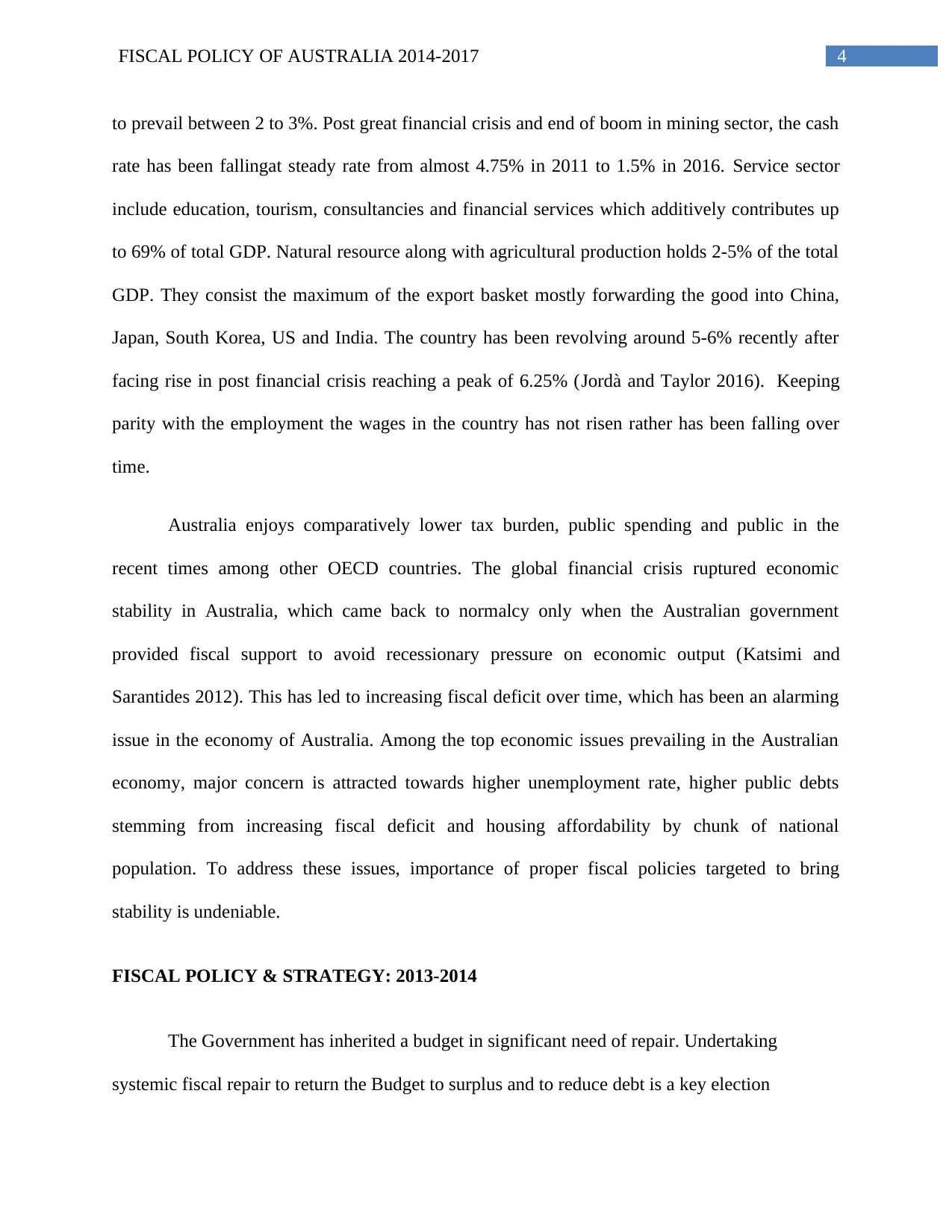
4FISCAL POLICY OF AUSTRALIA 2014-2017
to prevail between 2 to 3%. Post great financial crisis and end of boom in mining sector, the cash
rate has been fallingat steady rate from almost 4.75% in 2011 to 1.5% in 2016. Service sector
include education, tourism, consultancies and financial services which additively contributes up
to 69% of total GDP. Natural resource along with agricultural production holds 2-5% of the total
GDP. They consist the maximum of the export basket mostly forwarding the good into China,
Japan, South Korea, US and India. The country has been revolving around 5-6% recently after
facing rise in post financial crisis reaching a peak of 6.25% (Jordà and Taylor 2016). Keeping
parity with the employment the wages in the country has not risen rather has been falling over
time.
Australia enjoys comparatively lower tax burden, public spending and public in the
recent times among other OECD countries. The global financial crisis ruptured economic
stability in Australia, which came back to normalcy only when the Australian government
provided fiscal support to avoid recessionary pressure on economic output (Katsimi and
Sarantides 2012). This has led to increasing fiscal deficit over time, which has been an alarming
issue in the economy of Australia. Among the top economic issues prevailing in the Australian
economy, major concern is attracted towards higher unemployment rate, higher public debts
stemming from increasing fiscal deficit and housing affordability by chunk of national
population. To address these issues, importance of proper fiscal policies targeted to bring
stability is undeniable.
FISCAL POLICY & STRATEGY: 2013-2014
The Government has inherited a budget in significant need of repair. Undertaking
systemic fiscal repair to return the Budget to surplus and to reduce debt is a key election
to prevail between 2 to 3%. Post great financial crisis and end of boom in mining sector, the cash
rate has been fallingat steady rate from almost 4.75% in 2011 to 1.5% in 2016. Service sector
include education, tourism, consultancies and financial services which additively contributes up
to 69% of total GDP. Natural resource along with agricultural production holds 2-5% of the total
GDP. They consist the maximum of the export basket mostly forwarding the good into China,
Japan, South Korea, US and India. The country has been revolving around 5-6% recently after
facing rise in post financial crisis reaching a peak of 6.25% (Jordà and Taylor 2016). Keeping
parity with the employment the wages in the country has not risen rather has been falling over
time.
Australia enjoys comparatively lower tax burden, public spending and public in the
recent times among other OECD countries. The global financial crisis ruptured economic
stability in Australia, which came back to normalcy only when the Australian government
provided fiscal support to avoid recessionary pressure on economic output (Katsimi and
Sarantides 2012). This has led to increasing fiscal deficit over time, which has been an alarming
issue in the economy of Australia. Among the top economic issues prevailing in the Australian
economy, major concern is attracted towards higher unemployment rate, higher public debts
stemming from increasing fiscal deficit and housing affordability by chunk of national
population. To address these issues, importance of proper fiscal policies targeted to bring
stability is undeniable.
FISCAL POLICY & STRATEGY: 2013-2014
The Government has inherited a budget in significant need of repair. Undertaking
systemic fiscal repair to return the Budget to surplus and to reduce debt is a key election
Paraphrase This Document
Need a fresh take? Get an instant paraphrase of this document with our AI Paraphraser
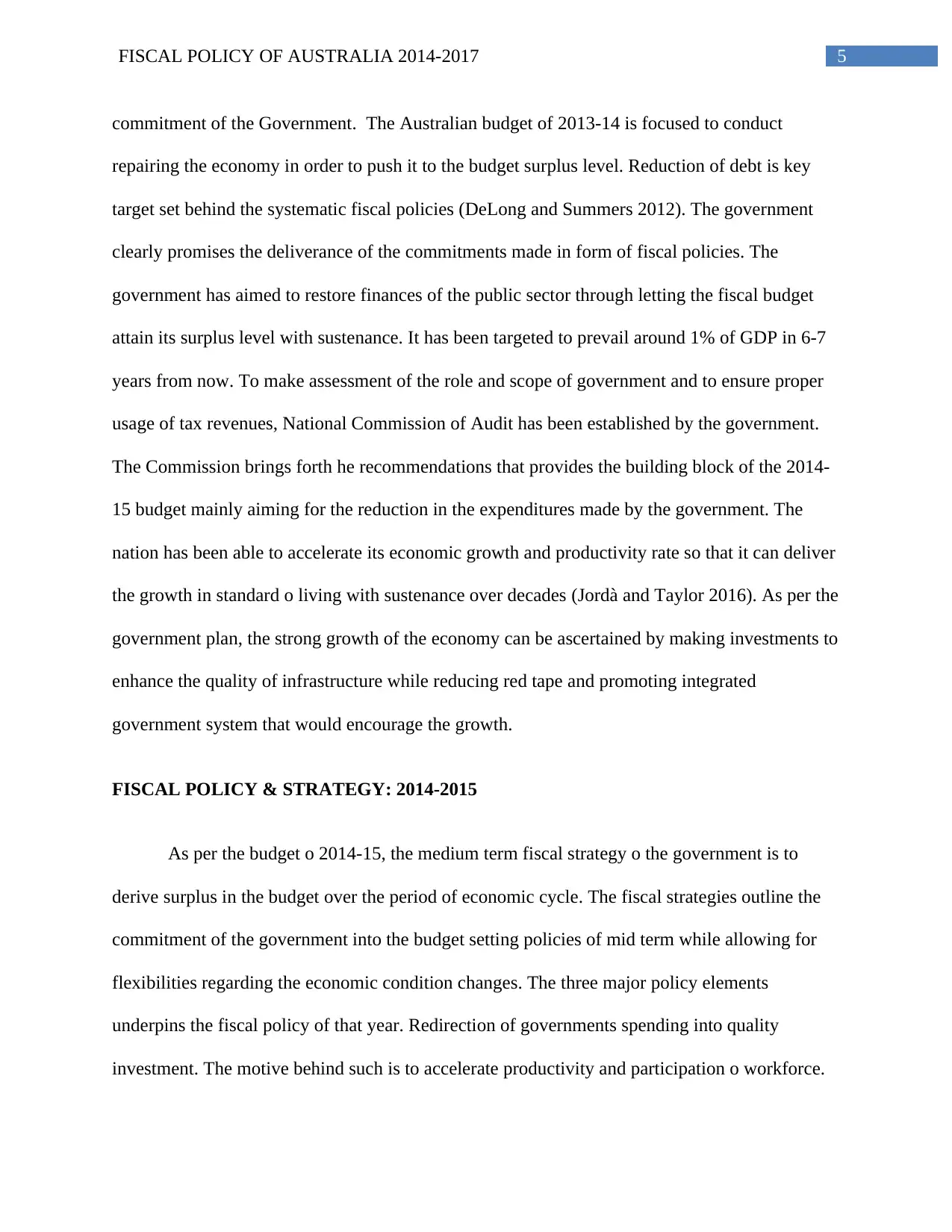
5FISCAL POLICY OF AUSTRALIA 2014-2017
commitment of the Government. The Australian budget of 2013-14 is focused to conduct
repairing the economy in order to push it to the budget surplus level. Reduction of debt is key
target set behind the systematic fiscal policies (DeLong and Summers 2012). The government
clearly promises the deliverance of the commitments made in form of fiscal policies. The
government has aimed to restore finances of the public sector through letting the fiscal budget
attain its surplus level with sustenance. It has been targeted to prevail around 1% of GDP in 6-7
years from now. To make assessment of the role and scope of government and to ensure proper
usage of tax revenues, National Commission of Audit has been established by the government.
The Commission brings forth he recommendations that provides the building block of the 2014-
15 budget mainly aiming for the reduction in the expenditures made by the government. The
nation has been able to accelerate its economic growth and productivity rate so that it can deliver
the growth in standard o living with sustenance over decades (Jordà and Taylor 2016). As per the
government plan, the strong growth of the economy can be ascertained by making investments to
enhance the quality of infrastructure while reducing red tape and promoting integrated
government system that would encourage the growth.
FISCAL POLICY & STRATEGY: 2014-2015
As per the budget o 2014-15, the medium term fiscal strategy o the government is to
derive surplus in the budget over the period of economic cycle. The fiscal strategies outline the
commitment of the government into the budget setting policies of mid term while allowing for
flexibilities regarding the economic condition changes. The three major policy elements
underpins the fiscal policy of that year. Redirection of governments spending into quality
investment. The motive behind such is to accelerate productivity and participation o workforce.
commitment of the Government. The Australian budget of 2013-14 is focused to conduct
repairing the economy in order to push it to the budget surplus level. Reduction of debt is key
target set behind the systematic fiscal policies (DeLong and Summers 2012). The government
clearly promises the deliverance of the commitments made in form of fiscal policies. The
government has aimed to restore finances of the public sector through letting the fiscal budget
attain its surplus level with sustenance. It has been targeted to prevail around 1% of GDP in 6-7
years from now. To make assessment of the role and scope of government and to ensure proper
usage of tax revenues, National Commission of Audit has been established by the government.
The Commission brings forth he recommendations that provides the building block of the 2014-
15 budget mainly aiming for the reduction in the expenditures made by the government. The
nation has been able to accelerate its economic growth and productivity rate so that it can deliver
the growth in standard o living with sustenance over decades (Jordà and Taylor 2016). As per the
government plan, the strong growth of the economy can be ascertained by making investments to
enhance the quality of infrastructure while reducing red tape and promoting integrated
government system that would encourage the growth.
FISCAL POLICY & STRATEGY: 2014-2015
As per the budget o 2014-15, the medium term fiscal strategy o the government is to
derive surplus in the budget over the period of economic cycle. The fiscal strategies outline the
commitment of the government into the budget setting policies of mid term while allowing for
flexibilities regarding the economic condition changes. The three major policy elements
underpins the fiscal policy of that year. Redirection of governments spending into quality
investment. The motive behind such is to accelerate productivity and participation o workforce.
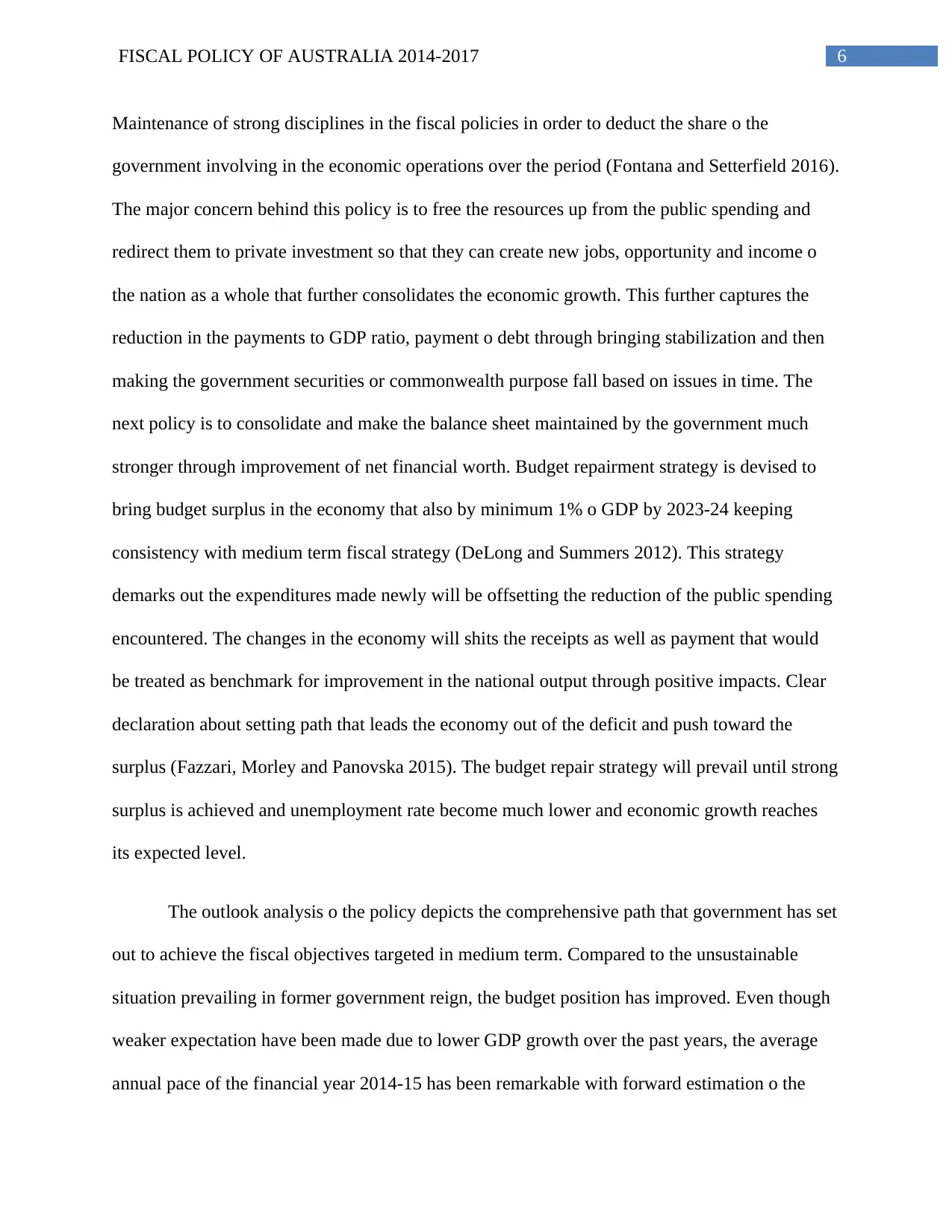
6FISCAL POLICY OF AUSTRALIA 2014-2017
Maintenance of strong disciplines in the fiscal policies in order to deduct the share o the
government involving in the economic operations over the period (Fontana and Setterfield 2016).
The major concern behind this policy is to free the resources up from the public spending and
redirect them to private investment so that they can create new jobs, opportunity and income o
the nation as a whole that further consolidates the economic growth. This further captures the
reduction in the payments to GDP ratio, payment o debt through bringing stabilization and then
making the government securities or commonwealth purpose fall based on issues in time. The
next policy is to consolidate and make the balance sheet maintained by the government much
stronger through improvement of net financial worth. Budget repairment strategy is devised to
bring budget surplus in the economy that also by minimum 1% o GDP by 2023-24 keeping
consistency with medium term fiscal strategy (DeLong and Summers 2012). This strategy
demarks out the expenditures made newly will be offsetting the reduction of the public spending
encountered. The changes in the economy will shits the receipts as well as payment that would
be treated as benchmark for improvement in the national output through positive impacts. Clear
declaration about setting path that leads the economy out of the deficit and push toward the
surplus (Fazzari, Morley and Panovska 2015). The budget repair strategy will prevail until strong
surplus is achieved and unemployment rate become much lower and economic growth reaches
its expected level.
The outlook analysis o the policy depicts the comprehensive path that government has set
out to achieve the fiscal objectives targeted in medium term. Compared to the unsustainable
situation prevailing in former government reign, the budget position has improved. Even though
weaker expectation have been made due to lower GDP growth over the past years, the average
annual pace of the financial year 2014-15 has been remarkable with forward estimation o the
Maintenance of strong disciplines in the fiscal policies in order to deduct the share o the
government involving in the economic operations over the period (Fontana and Setterfield 2016).
The major concern behind this policy is to free the resources up from the public spending and
redirect them to private investment so that they can create new jobs, opportunity and income o
the nation as a whole that further consolidates the economic growth. This further captures the
reduction in the payments to GDP ratio, payment o debt through bringing stabilization and then
making the government securities or commonwealth purpose fall based on issues in time. The
next policy is to consolidate and make the balance sheet maintained by the government much
stronger through improvement of net financial worth. Budget repairment strategy is devised to
bring budget surplus in the economy that also by minimum 1% o GDP by 2023-24 keeping
consistency with medium term fiscal strategy (DeLong and Summers 2012). This strategy
demarks out the expenditures made newly will be offsetting the reduction of the public spending
encountered. The changes in the economy will shits the receipts as well as payment that would
be treated as benchmark for improvement in the national output through positive impacts. Clear
declaration about setting path that leads the economy out of the deficit and push toward the
surplus (Fazzari, Morley and Panovska 2015). The budget repair strategy will prevail until strong
surplus is achieved and unemployment rate become much lower and economic growth reaches
its expected level.
The outlook analysis o the policy depicts the comprehensive path that government has set
out to achieve the fiscal objectives targeted in medium term. Compared to the unsustainable
situation prevailing in former government reign, the budget position has improved. Even though
weaker expectation have been made due to lower GDP growth over the past years, the average
annual pace of the financial year 2014-15 has been remarkable with forward estimation o the
⊘ This is a preview!⊘
Do you want full access?
Subscribe today to unlock all pages.

Trusted by 1+ million students worldwide
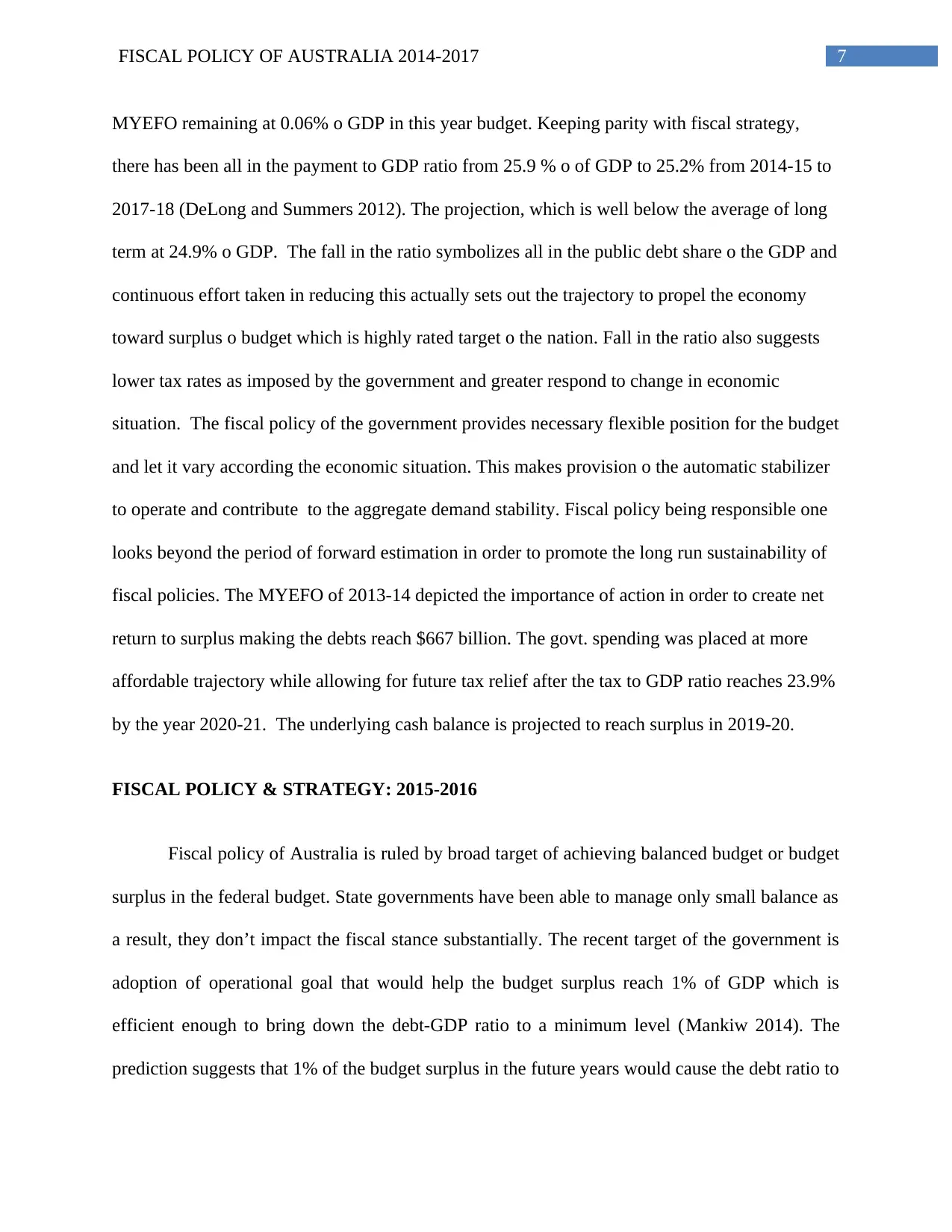
7FISCAL POLICY OF AUSTRALIA 2014-2017
MYEFO remaining at 0.06% o GDP in this year budget. Keeping parity with fiscal strategy,
there has been all in the payment to GDP ratio from 25.9 % o of GDP to 25.2% from 2014-15 to
2017-18 (DeLong and Summers 2012). The projection, which is well below the average of long
term at 24.9% o GDP. The fall in the ratio symbolizes all in the public debt share o the GDP and
continuous effort taken in reducing this actually sets out the trajectory to propel the economy
toward surplus o budget which is highly rated target o the nation. Fall in the ratio also suggests
lower tax rates as imposed by the government and greater respond to change in economic
situation. The fiscal policy of the government provides necessary flexible position for the budget
and let it vary according the economic situation. This makes provision o the automatic stabilizer
to operate and contribute to the aggregate demand stability. Fiscal policy being responsible one
looks beyond the period of forward estimation in order to promote the long run sustainability of
fiscal policies. The MYEFO of 2013-14 depicted the importance of action in order to create net
return to surplus making the debts reach $667 billion. The govt. spending was placed at more
affordable trajectory while allowing for future tax relief after the tax to GDP ratio reaches 23.9%
by the year 2020-21. The underlying cash balance is projected to reach surplus in 2019-20.
FISCAL POLICY & STRATEGY: 2015-2016
Fiscal policy of Australia is ruled by broad target of achieving balanced budget or budget
surplus in the federal budget. State governments have been able to manage only small balance as
a result, they don’t impact the fiscal stance substantially. The recent target of the government is
adoption of operational goal that would help the budget surplus reach 1% of GDP which is
efficient enough to bring down the debt-GDP ratio to a minimum level (Mankiw 2014). The
prediction suggests that 1% of the budget surplus in the future years would cause the debt ratio to
MYEFO remaining at 0.06% o GDP in this year budget. Keeping parity with fiscal strategy,
there has been all in the payment to GDP ratio from 25.9 % o of GDP to 25.2% from 2014-15 to
2017-18 (DeLong and Summers 2012). The projection, which is well below the average of long
term at 24.9% o GDP. The fall in the ratio symbolizes all in the public debt share o the GDP and
continuous effort taken in reducing this actually sets out the trajectory to propel the economy
toward surplus o budget which is highly rated target o the nation. Fall in the ratio also suggests
lower tax rates as imposed by the government and greater respond to change in economic
situation. The fiscal policy of the government provides necessary flexible position for the budget
and let it vary according the economic situation. This makes provision o the automatic stabilizer
to operate and contribute to the aggregate demand stability. Fiscal policy being responsible one
looks beyond the period of forward estimation in order to promote the long run sustainability of
fiscal policies. The MYEFO of 2013-14 depicted the importance of action in order to create net
return to surplus making the debts reach $667 billion. The govt. spending was placed at more
affordable trajectory while allowing for future tax relief after the tax to GDP ratio reaches 23.9%
by the year 2020-21. The underlying cash balance is projected to reach surplus in 2019-20.
FISCAL POLICY & STRATEGY: 2015-2016
Fiscal policy of Australia is ruled by broad target of achieving balanced budget or budget
surplus in the federal budget. State governments have been able to manage only small balance as
a result, they don’t impact the fiscal stance substantially. The recent target of the government is
adoption of operational goal that would help the budget surplus reach 1% of GDP which is
efficient enough to bring down the debt-GDP ratio to a minimum level (Mankiw 2014). The
prediction suggests that 1% of the budget surplus in the future years would cause the debt ratio to
Paraphrase This Document
Need a fresh take? Get an instant paraphrase of this document with our AI Paraphraser
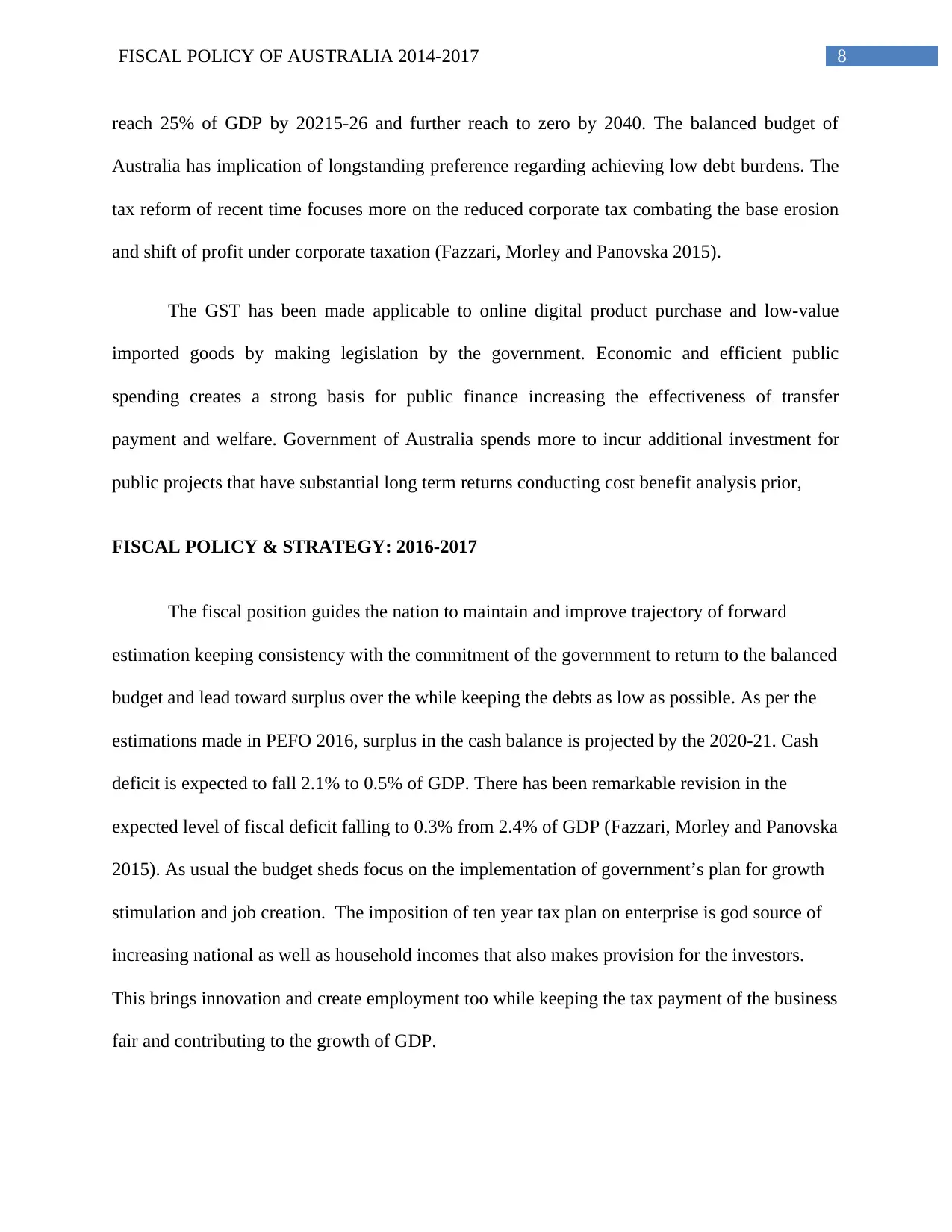
8FISCAL POLICY OF AUSTRALIA 2014-2017
reach 25% of GDP by 20215-26 and further reach to zero by 2040. The balanced budget of
Australia has implication of longstanding preference regarding achieving low debt burdens. The
tax reform of recent time focuses more on the reduced corporate tax combating the base erosion
and shift of profit under corporate taxation (Fazzari, Morley and Panovska 2015).
The GST has been made applicable to online digital product purchase and low-value
imported goods by making legislation by the government. Economic and efficient public
spending creates a strong basis for public finance increasing the effectiveness of transfer
payment and welfare. Government of Australia spends more to incur additional investment for
public projects that have substantial long term returns conducting cost benefit analysis prior,
FISCAL POLICY & STRATEGY: 2016-2017
The fiscal position guides the nation to maintain and improve trajectory of forward
estimation keeping consistency with the commitment of the government to return to the balanced
budget and lead toward surplus over the while keeping the debts as low as possible. As per the
estimations made in PEFO 2016, surplus in the cash balance is projected by the 2020-21. Cash
deficit is expected to fall 2.1% to 0.5% of GDP. There has been remarkable revision in the
expected level of fiscal deficit falling to 0.3% from 2.4% of GDP (Fazzari, Morley and Panovska
2015). As usual the budget sheds focus on the implementation of government’s plan for growth
stimulation and job creation. The imposition of ten year tax plan on enterprise is god source of
increasing national as well as household incomes that also makes provision for the investors.
This brings innovation and create employment too while keeping the tax payment of the business
fair and contributing to the growth of GDP.
reach 25% of GDP by 20215-26 and further reach to zero by 2040. The balanced budget of
Australia has implication of longstanding preference regarding achieving low debt burdens. The
tax reform of recent time focuses more on the reduced corporate tax combating the base erosion
and shift of profit under corporate taxation (Fazzari, Morley and Panovska 2015).
The GST has been made applicable to online digital product purchase and low-value
imported goods by making legislation by the government. Economic and efficient public
spending creates a strong basis for public finance increasing the effectiveness of transfer
payment and welfare. Government of Australia spends more to incur additional investment for
public projects that have substantial long term returns conducting cost benefit analysis prior,
FISCAL POLICY & STRATEGY: 2016-2017
The fiscal position guides the nation to maintain and improve trajectory of forward
estimation keeping consistency with the commitment of the government to return to the balanced
budget and lead toward surplus over the while keeping the debts as low as possible. As per the
estimations made in PEFO 2016, surplus in the cash balance is projected by the 2020-21. Cash
deficit is expected to fall 2.1% to 0.5% of GDP. There has been remarkable revision in the
expected level of fiscal deficit falling to 0.3% from 2.4% of GDP (Fazzari, Morley and Panovska
2015). As usual the budget sheds focus on the implementation of government’s plan for growth
stimulation and job creation. The imposition of ten year tax plan on enterprise is god source of
increasing national as well as household incomes that also makes provision for the investors.
This brings innovation and create employment too while keeping the tax payment of the business
fair and contributing to the growth of GDP.
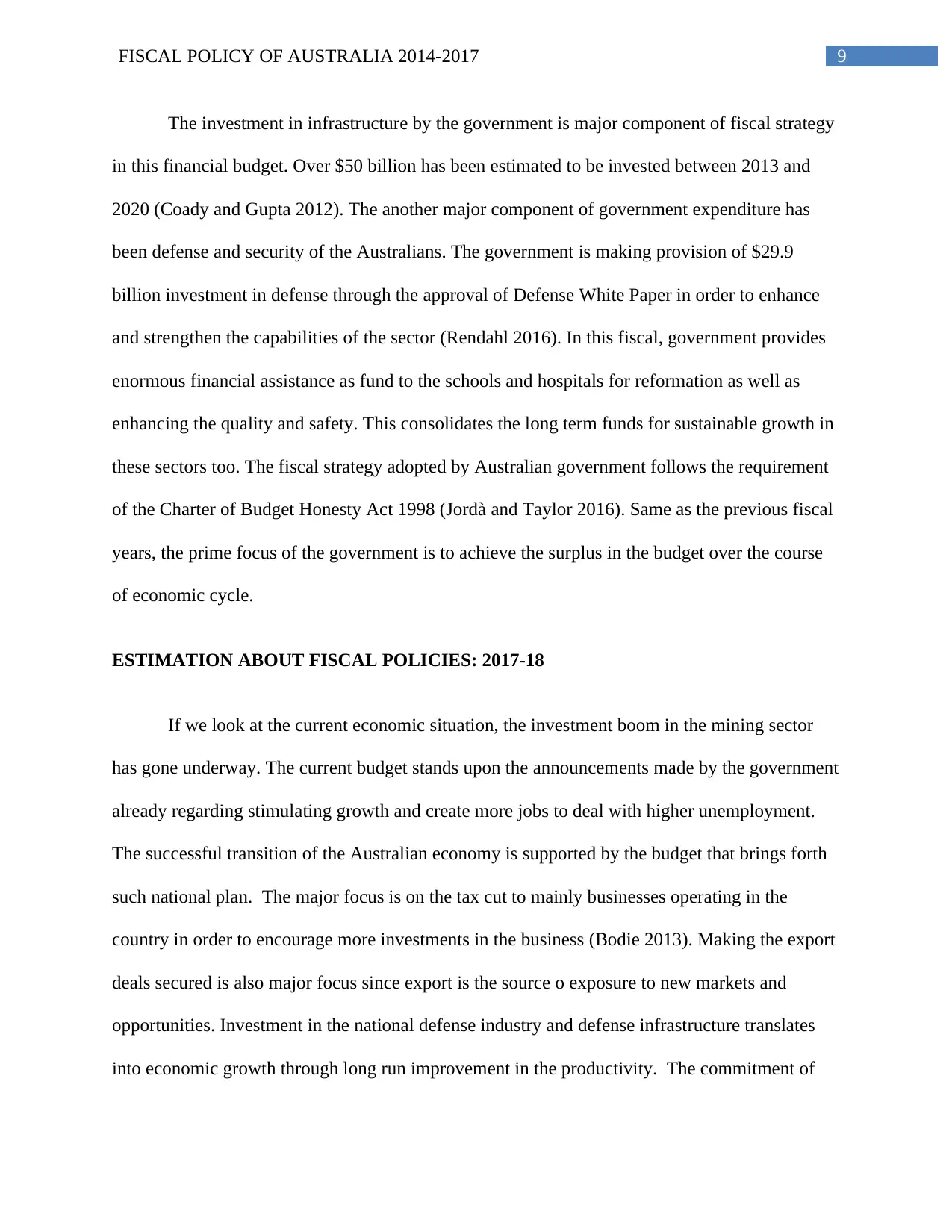
9FISCAL POLICY OF AUSTRALIA 2014-2017
The investment in infrastructure by the government is major component of fiscal strategy
in this financial budget. Over $50 billion has been estimated to be invested between 2013 and
2020 (Coady and Gupta 2012). The another major component of government expenditure has
been defense and security of the Australians. The government is making provision of $29.9
billion investment in defense through the approval of Defense White Paper in order to enhance
and strengthen the capabilities of the sector (Rendahl 2016). In this fiscal, government provides
enormous financial assistance as fund to the schools and hospitals for reformation as well as
enhancing the quality and safety. This consolidates the long term funds for sustainable growth in
these sectors too. The fiscal strategy adopted by Australian government follows the requirement
of the Charter of Budget Honesty Act 1998 (Jordà and Taylor 2016). Same as the previous fiscal
years, the prime focus of the government is to achieve the surplus in the budget over the course
of economic cycle.
ESTIMATION ABOUT FISCAL POLICIES: 2017-18
If we look at the current economic situation, the investment boom in the mining sector
has gone underway. The current budget stands upon the announcements made by the government
already regarding stimulating growth and create more jobs to deal with higher unemployment.
The successful transition of the Australian economy is supported by the budget that brings forth
such national plan. The major focus is on the tax cut to mainly businesses operating in the
country in order to encourage more investments in the business (Bodie 2013). Making the export
deals secured is also major focus since export is the source o exposure to new markets and
opportunities. Investment in the national defense industry and defense infrastructure translates
into economic growth through long run improvement in the productivity. The commitment of
The investment in infrastructure by the government is major component of fiscal strategy
in this financial budget. Over $50 billion has been estimated to be invested between 2013 and
2020 (Coady and Gupta 2012). The another major component of government expenditure has
been defense and security of the Australians. The government is making provision of $29.9
billion investment in defense through the approval of Defense White Paper in order to enhance
and strengthen the capabilities of the sector (Rendahl 2016). In this fiscal, government provides
enormous financial assistance as fund to the schools and hospitals for reformation as well as
enhancing the quality and safety. This consolidates the long term funds for sustainable growth in
these sectors too. The fiscal strategy adopted by Australian government follows the requirement
of the Charter of Budget Honesty Act 1998 (Jordà and Taylor 2016). Same as the previous fiscal
years, the prime focus of the government is to achieve the surplus in the budget over the course
of economic cycle.
ESTIMATION ABOUT FISCAL POLICIES: 2017-18
If we look at the current economic situation, the investment boom in the mining sector
has gone underway. The current budget stands upon the announcements made by the government
already regarding stimulating growth and create more jobs to deal with higher unemployment.
The successful transition of the Australian economy is supported by the budget that brings forth
such national plan. The major focus is on the tax cut to mainly businesses operating in the
country in order to encourage more investments in the business (Bodie 2013). Making the export
deals secured is also major focus since export is the source o exposure to new markets and
opportunities. Investment in the national defense industry and defense infrastructure translates
into economic growth through long run improvement in the productivity. The commitment of
⊘ This is a preview!⊘
Do you want full access?
Subscribe today to unlock all pages.

Trusted by 1+ million students worldwide
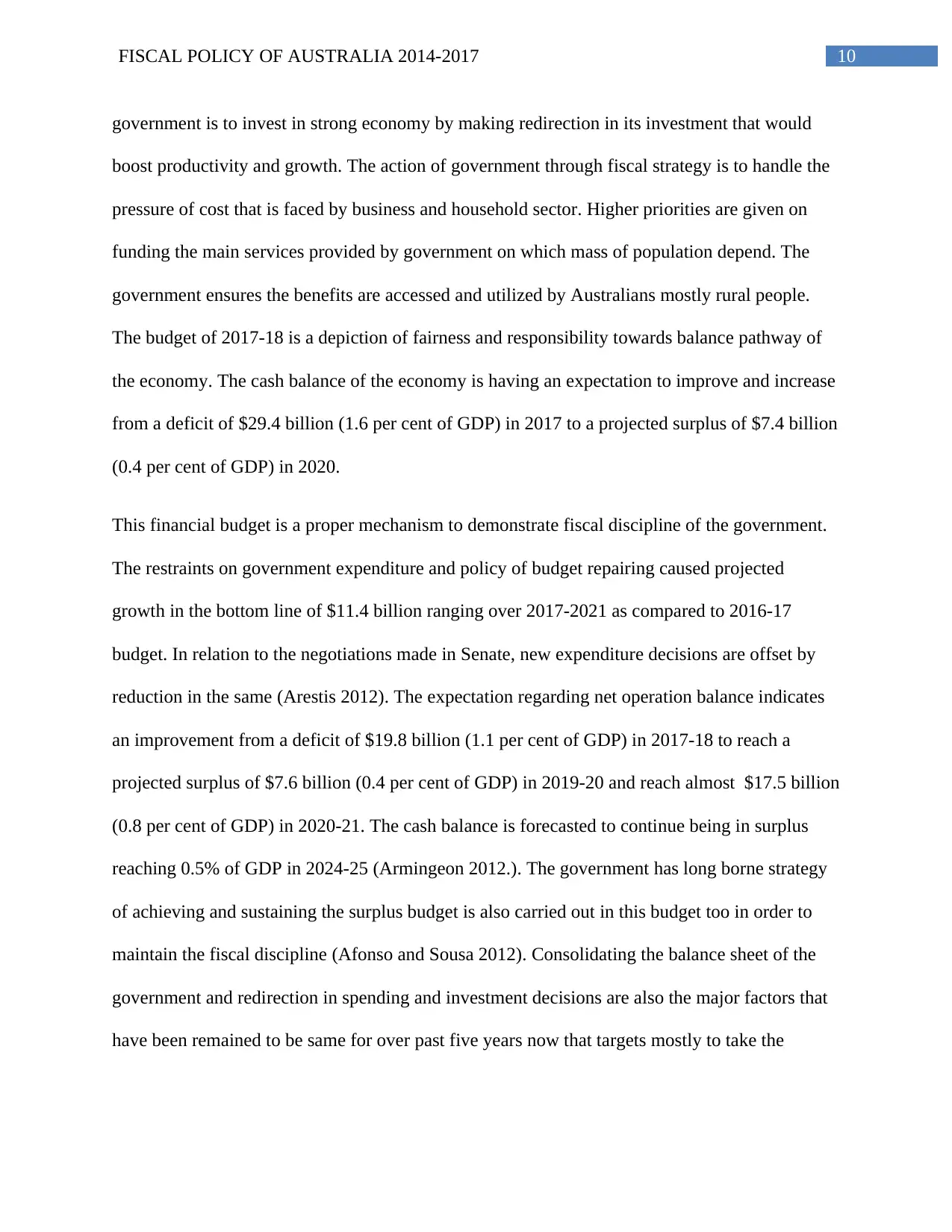
10FISCAL POLICY OF AUSTRALIA 2014-2017
government is to invest in strong economy by making redirection in its investment that would
boost productivity and growth. The action of government through fiscal strategy is to handle the
pressure of cost that is faced by business and household sector. Higher priorities are given on
funding the main services provided by government on which mass of population depend. The
government ensures the benefits are accessed and utilized by Australians mostly rural people.
The budget of 2017-18 is a depiction of fairness and responsibility towards balance pathway of
the economy. The cash balance of the economy is having an expectation to improve and increase
from a deficit of $29.4 billion (1.6 per cent of GDP) in 2017 to a projected surplus of $7.4 billion
(0.4 per cent of GDP) in 2020.
This financial budget is a proper mechanism to demonstrate fiscal discipline of the government.
The restraints on government expenditure and policy of budget repairing caused projected
growth in the bottom line of $11.4 billion ranging over 2017-2021 as compared to 2016-17
budget. In relation to the negotiations made in Senate, new expenditure decisions are offset by
reduction in the same (Arestis 2012). The expectation regarding net operation balance indicates
an improvement from a deficit of $19.8 billion (1.1 per cent of GDP) in 2017-18 to reach a
projected surplus of $7.6 billion (0.4 per cent of GDP) in 2019-20 and reach almost $17.5 billion
(0.8 per cent of GDP) in 2020-21. The cash balance is forecasted to continue being in surplus
reaching 0.5% of GDP in 2024-25 (Armingeon 2012.). The government has long borne strategy
of achieving and sustaining the surplus budget is also carried out in this budget too in order to
maintain the fiscal discipline (Afonso and Sousa 2012). Consolidating the balance sheet of the
government and redirection in spending and investment decisions are also the major factors that
have been remained to be same for over past five years now that targets mostly to take the
government is to invest in strong economy by making redirection in its investment that would
boost productivity and growth. The action of government through fiscal strategy is to handle the
pressure of cost that is faced by business and household sector. Higher priorities are given on
funding the main services provided by government on which mass of population depend. The
government ensures the benefits are accessed and utilized by Australians mostly rural people.
The budget of 2017-18 is a depiction of fairness and responsibility towards balance pathway of
the economy. The cash balance of the economy is having an expectation to improve and increase
from a deficit of $29.4 billion (1.6 per cent of GDP) in 2017 to a projected surplus of $7.4 billion
(0.4 per cent of GDP) in 2020.
This financial budget is a proper mechanism to demonstrate fiscal discipline of the government.
The restraints on government expenditure and policy of budget repairing caused projected
growth in the bottom line of $11.4 billion ranging over 2017-2021 as compared to 2016-17
budget. In relation to the negotiations made in Senate, new expenditure decisions are offset by
reduction in the same (Arestis 2012). The expectation regarding net operation balance indicates
an improvement from a deficit of $19.8 billion (1.1 per cent of GDP) in 2017-18 to reach a
projected surplus of $7.6 billion (0.4 per cent of GDP) in 2019-20 and reach almost $17.5 billion
(0.8 per cent of GDP) in 2020-21. The cash balance is forecasted to continue being in surplus
reaching 0.5% of GDP in 2024-25 (Armingeon 2012.). The government has long borne strategy
of achieving and sustaining the surplus budget is also carried out in this budget too in order to
maintain the fiscal discipline (Afonso and Sousa 2012). Consolidating the balance sheet of the
government and redirection in spending and investment decisions are also the major factors that
have been remained to be same for over past five years now that targets mostly to take the
Paraphrase This Document
Need a fresh take? Get an instant paraphrase of this document with our AI Paraphraser
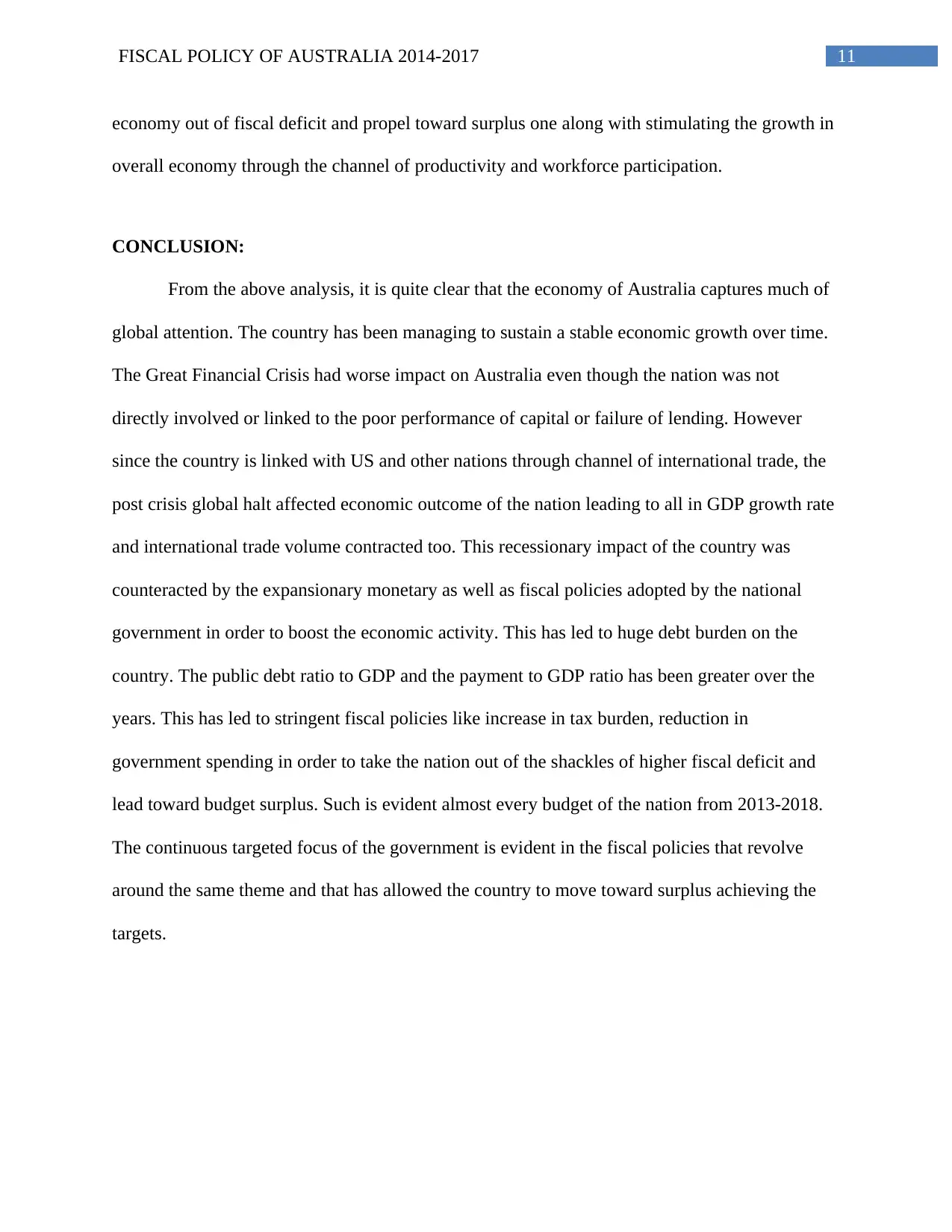
11FISCAL POLICY OF AUSTRALIA 2014-2017
economy out of fiscal deficit and propel toward surplus one along with stimulating the growth in
overall economy through the channel of productivity and workforce participation.
CONCLUSION:
From the above analysis, it is quite clear that the economy of Australia captures much of
global attention. The country has been managing to sustain a stable economic growth over time.
The Great Financial Crisis had worse impact on Australia even though the nation was not
directly involved or linked to the poor performance of capital or failure of lending. However
since the country is linked with US and other nations through channel of international trade, the
post crisis global halt affected economic outcome of the nation leading to all in GDP growth rate
and international trade volume contracted too. This recessionary impact of the country was
counteracted by the expansionary monetary as well as fiscal policies adopted by the national
government in order to boost the economic activity. This has led to huge debt burden on the
country. The public debt ratio to GDP and the payment to GDP ratio has been greater over the
years. This has led to stringent fiscal policies like increase in tax burden, reduction in
government spending in order to take the nation out of the shackles of higher fiscal deficit and
lead toward budget surplus. Such is evident almost every budget of the nation from 2013-2018.
The continuous targeted focus of the government is evident in the fiscal policies that revolve
around the same theme and that has allowed the country to move toward surplus achieving the
targets.
economy out of fiscal deficit and propel toward surplus one along with stimulating the growth in
overall economy through the channel of productivity and workforce participation.
CONCLUSION:
From the above analysis, it is quite clear that the economy of Australia captures much of
global attention. The country has been managing to sustain a stable economic growth over time.
The Great Financial Crisis had worse impact on Australia even though the nation was not
directly involved or linked to the poor performance of capital or failure of lending. However
since the country is linked with US and other nations through channel of international trade, the
post crisis global halt affected economic outcome of the nation leading to all in GDP growth rate
and international trade volume contracted too. This recessionary impact of the country was
counteracted by the expansionary monetary as well as fiscal policies adopted by the national
government in order to boost the economic activity. This has led to huge debt burden on the
country. The public debt ratio to GDP and the payment to GDP ratio has been greater over the
years. This has led to stringent fiscal policies like increase in tax burden, reduction in
government spending in order to take the nation out of the shackles of higher fiscal deficit and
lead toward budget surplus. Such is evident almost every budget of the nation from 2013-2018.
The continuous targeted focus of the government is evident in the fiscal policies that revolve
around the same theme and that has allowed the country to move toward surplus achieving the
targets.
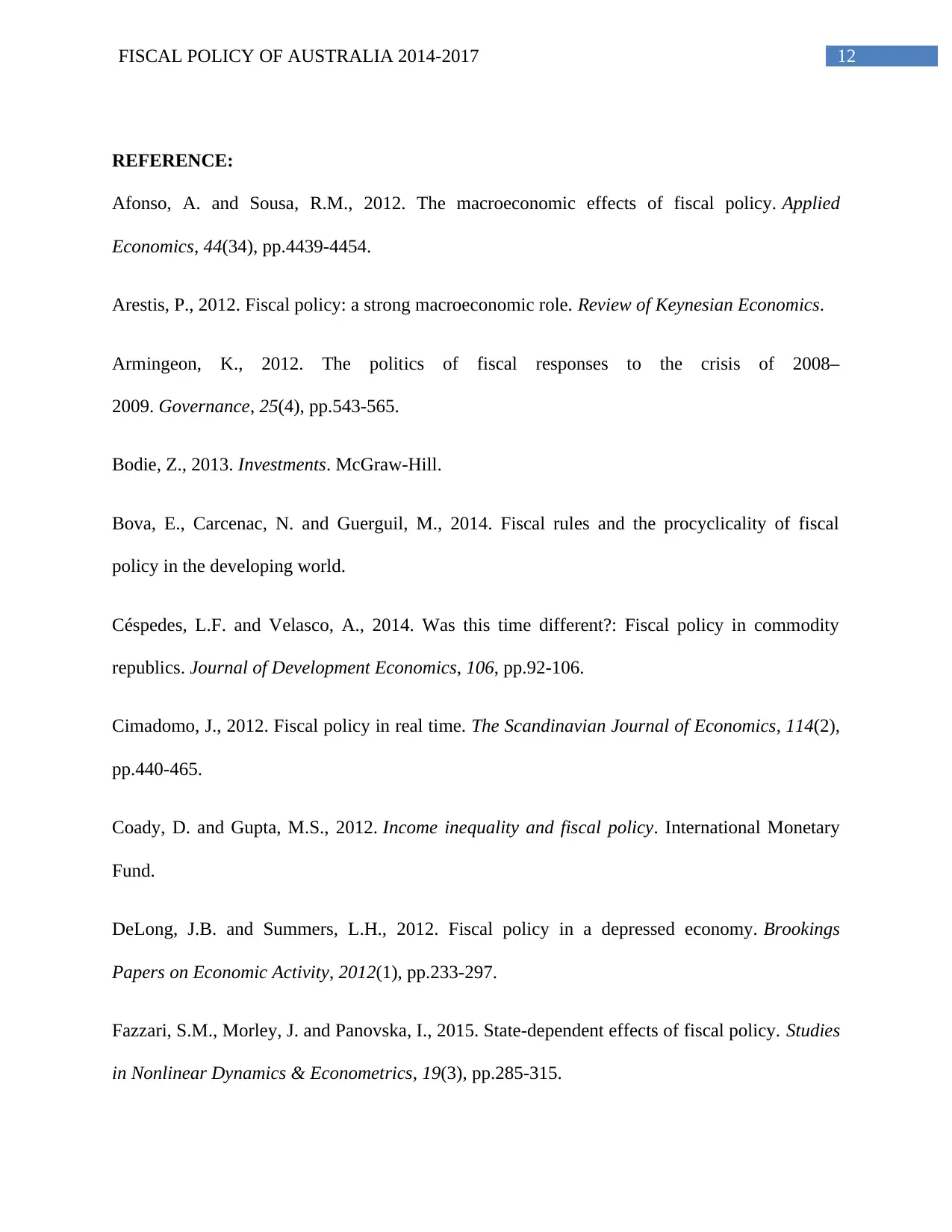
12FISCAL POLICY OF AUSTRALIA 2014-2017
REFERENCE:
Afonso, A. and Sousa, R.M., 2012. The macroeconomic effects of fiscal policy. Applied
Economics, 44(34), pp.4439-4454.
Arestis, P., 2012. Fiscal policy: a strong macroeconomic role. Review of Keynesian Economics.
Armingeon, K., 2012. The politics of fiscal responses to the crisis of 2008–
2009. Governance, 25(4), pp.543-565.
Bodie, Z., 2013. Investments. McGraw-Hill.
Bova, E., Carcenac, N. and Guerguil, M., 2014. Fiscal rules and the procyclicality of fiscal
policy in the developing world.
Céspedes, L.F. and Velasco, A., 2014. Was this time different?: Fiscal policy in commodity
republics. Journal of Development Economics, 106, pp.92-106.
Cimadomo, J., 2012. Fiscal policy in real time. The Scandinavian Journal of Economics, 114(2),
pp.440-465.
Coady, D. and Gupta, M.S., 2012. Income inequality and fiscal policy. International Monetary
Fund.
DeLong, J.B. and Summers, L.H., 2012. Fiscal policy in a depressed economy. Brookings
Papers on Economic Activity, 2012(1), pp.233-297.
Fazzari, S.M., Morley, J. and Panovska, I., 2015. State-dependent effects of fiscal policy. Studies
in Nonlinear Dynamics & Econometrics, 19(3), pp.285-315.
REFERENCE:
Afonso, A. and Sousa, R.M., 2012. The macroeconomic effects of fiscal policy. Applied
Economics, 44(34), pp.4439-4454.
Arestis, P., 2012. Fiscal policy: a strong macroeconomic role. Review of Keynesian Economics.
Armingeon, K., 2012. The politics of fiscal responses to the crisis of 2008–
2009. Governance, 25(4), pp.543-565.
Bodie, Z., 2013. Investments. McGraw-Hill.
Bova, E., Carcenac, N. and Guerguil, M., 2014. Fiscal rules and the procyclicality of fiscal
policy in the developing world.
Céspedes, L.F. and Velasco, A., 2014. Was this time different?: Fiscal policy in commodity
republics. Journal of Development Economics, 106, pp.92-106.
Cimadomo, J., 2012. Fiscal policy in real time. The Scandinavian Journal of Economics, 114(2),
pp.440-465.
Coady, D. and Gupta, M.S., 2012. Income inequality and fiscal policy. International Monetary
Fund.
DeLong, J.B. and Summers, L.H., 2012. Fiscal policy in a depressed economy. Brookings
Papers on Economic Activity, 2012(1), pp.233-297.
Fazzari, S.M., Morley, J. and Panovska, I., 2015. State-dependent effects of fiscal policy. Studies
in Nonlinear Dynamics & Econometrics, 19(3), pp.285-315.
⊘ This is a preview!⊘
Do you want full access?
Subscribe today to unlock all pages.

Trusted by 1+ million students worldwide
1 out of 13
Related Documents
Your All-in-One AI-Powered Toolkit for Academic Success.
+13062052269
info@desklib.com
Available 24*7 on WhatsApp / Email
![[object Object]](/_next/static/media/star-bottom.7253800d.svg)
Unlock your academic potential
Copyright © 2020–2025 A2Z Services. All Rights Reserved. Developed and managed by ZUCOL.





